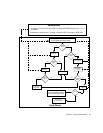
Chapter 3 System Administration 71
About Managing the System
The following sections provide an overview of the Solaris Operating Environment
system management software, the system device test firmware and operating
environment software, and the tools available for diagnosing problems with system
parts in your remote or your local server(s).
The new tool set, described in the following sections, facilitates system management:
■ “Managing and Monitoring System Performance” on page 71
■ “Isolating Failed Components” on page 72
■ “Diagnosing Intermittent Problems” on page 72
■ “Using the Sun Remote System Control (RSC) Card” on page 74
■ “About Storage Management Tools” on page 76
■ “About Personal Computer Connectivity” on page 78
Managing and Monitoring System Performance
The Solaris 8 Operating Environment supports the following suite of new software
applications and extends system management and administrative capabilities
network-wide:
■ Solaris Resource Manager™ software, which controls resource allocation to
applications, users, and user groups (not bundled with Solaris 8 software).
■ Solaris Bandwidth Manager software, which extends resource management
control to the network software.
■ Sun Remote System Control (RSC) software, which supports a graphical user
interface for using the RSC system monitoring features from the operating
environment level, and ok prompt access to the firmware. The software is
contained on the Solaris Supplement CD and is supported by the preinstalled
RSC card.
■ Sun Management Center software, which provides a single solution for
monitoring and managing multiple Sun servers and systems, devices, and
network resources from a single remote or local system.
■ Internet Protocol Network MultiPathing (IPMP) software, which enables
failover or redirection of network traffic among PCI networking cards
permitting, for example, the replacement of a system’s PCI card while network
traffic continues to use another configured card.
■ Sun Cluster 3.0 software, which provides higher levels of availability than is
possible with a single server by connecting a cluster of servers.


















